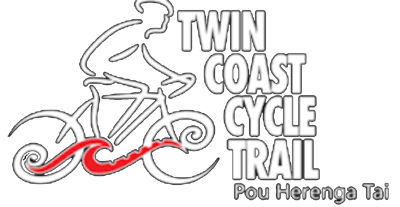Trail Safety
The Pou Herenga Tai – Twin Coast Cycle Trail includes both on and off-road cycle trails, each of which presents different safety considerations. Below is some general information to help keep you safe in the outdoors in any environment and more specific information relating to safety cycling on the road.
Safety in the Outdoors
The New Zealand Cycle Trail has adopted the New Zealand Mountain Safety Council’s Outdoor Safety Code, which can be applied across all types of outdoor activities, sports and recreation.
The five safety points below have been created through expert consultation and are the core to all outdoor safety practices.
All of the safety points can be expanded upon depending on the type of cycling you’re planning to do and the associated level of risk – so use them as a starting point and make sure you know all you can about the trail before you head off.
In an Emergency call 111 – NB: there is limited cell phone coverage across some parts of the trail.
Important – Don’t forget to lock your bike!

Dogs on the Trail
Dogs are permitted on a lead except in the following areas:
1. Between the Macadamia Orchard (Horeke Rd) through Mangataraire Roads. This is a 12.5km section of trail. (Okaihau to Horeke)
2. There are a number parcels of land adjacent to Horeke Road managed under the Utakura No. 7 Inc. which prohibit dogs and horses. (Okaihau to Horeke)
3. The section of cycle trail which comes off Ngapipito Road (Moerewa) and navigates to the suspension bridges also prohibits
dogs. (Kawakawa to Kaikohe)
4. The section of cycle trail which comes off Ngapipito Road (Moerewa) and navigates to the suspension bridges also prohibits dogs.
Please note: dogs must be on a lead at all times.
1. Plan your trip
Seek local knowledge and plan the route you will take and the amount of time you can reasonably expect it to take.
» Read more about how to plan your trip
2. Tell Someone Your Plans
Tell someone your plans and leave a date to raise the alarm if you haven’t returned.
The New Zealand Cycle Trail recommends that you don’t ride alone, especially if you’re heading into remote areas.
The New Zealand Outdoors Intentions Process (endorsed by New Zealand’s search and rescue agencies) provides 3 simple options which enable you to ‘tell someone’ all the details about your ride into the outdoors.
3. Be aware of the weather
New Zealand’s weather can be highly unpredictable. Always check the forecast before you head off and be prepared for weather changes. Just because you are in the Far North don’t think you don’t need to be prepared.
Sun in NZ is extremely harsh, causing dehydration, sunstroke and sunburn. Keep and eye out for wind and rain, and we have flood spots on the trail so please look at the weather for the area.
» Read more about how to be aware of the weather
4. Know your limits
Your responsibility is to enjoy and maximise your riding experience, while reducing and minimising the risk.
Challenge yourself, but ride within your physical limits and ability.
» Read more about how to know your limits
5. Take sufficient supplies
Make sure you have enough food, clothing, equipment and emergency rations for the worst-case scenario. Take some basic bike tools for any repairs and an appropriate means of communication.
» Read more about how to plan your trip
Northland Metservice
The central point of the trail is Kaikohe
The Twin Coast Cycle Trail runs from one coast to the other so weather can be different in the same day.
Safety on the Road
Following are a few simple tips to help keep you stay safe when you’re out on the road.
Be Seen – Wear high visibility or brightly coloured clothing. Use front and rear lights at night, in low light and in poor visibility such as fog or rain.
Be Aware – Watch and listen for approaching vehicles, pedestrians, potholes, animals, car doors opening and other potential hazards.
Be Predictable – Make eye contact with other road users. Maintain a straight line, keep to the left and signal your intentions clearly.
Be Confident – Know how to safely approach railway crossings, roundabouts and intersections etc. Use hand signals to indicate your intentions and a bell to alert other road users to your presence.
Be Safe – Ride to the conditions and follow the road rules. Cycle no more than two abreast and ride single file where visibility is an issue or traffic is busy. Keep at least one metre away from parked cars and use cycle lanes.
Be Patient – Slow down near parked or lined up vehicles. Pass slowly and only when safe. On narrow windy roads, pull over where practical to allow vehicles to pass.
Be Prepared – Wear an approved helmet and check your bike regularly. Plan your route and carry sufficient water and food, along with basic tools for any repairs.
Useful Links
The AdventureSmart website aims to provide both visitors and New Zealanders with a centralised online location for safety information and planning support, prior to engaging in outdoors activities in New Zealand. It provides lots of useful tips, links and advice to help you plan and prepare – to ensure you enjoy your adventure safely.
If you’re cycling on the road, you must know New Zealand’s road rules. The Official New Zealand Code for Cyclists, developed by the New Zealand Transport Agency, is a user-friendly guide to New Zealand’s traffic law and safe driving practices.
Bike Wise is a national cycling programme of activities, promoting cycling as a fun, healthy and safe way to travel in New Zealand. Bikewise month, held in February each year, encompasses a wide range of activities and events across the country. You’ll also find lots of information about cycling in general and how to keep safe on New Zealand roads.
